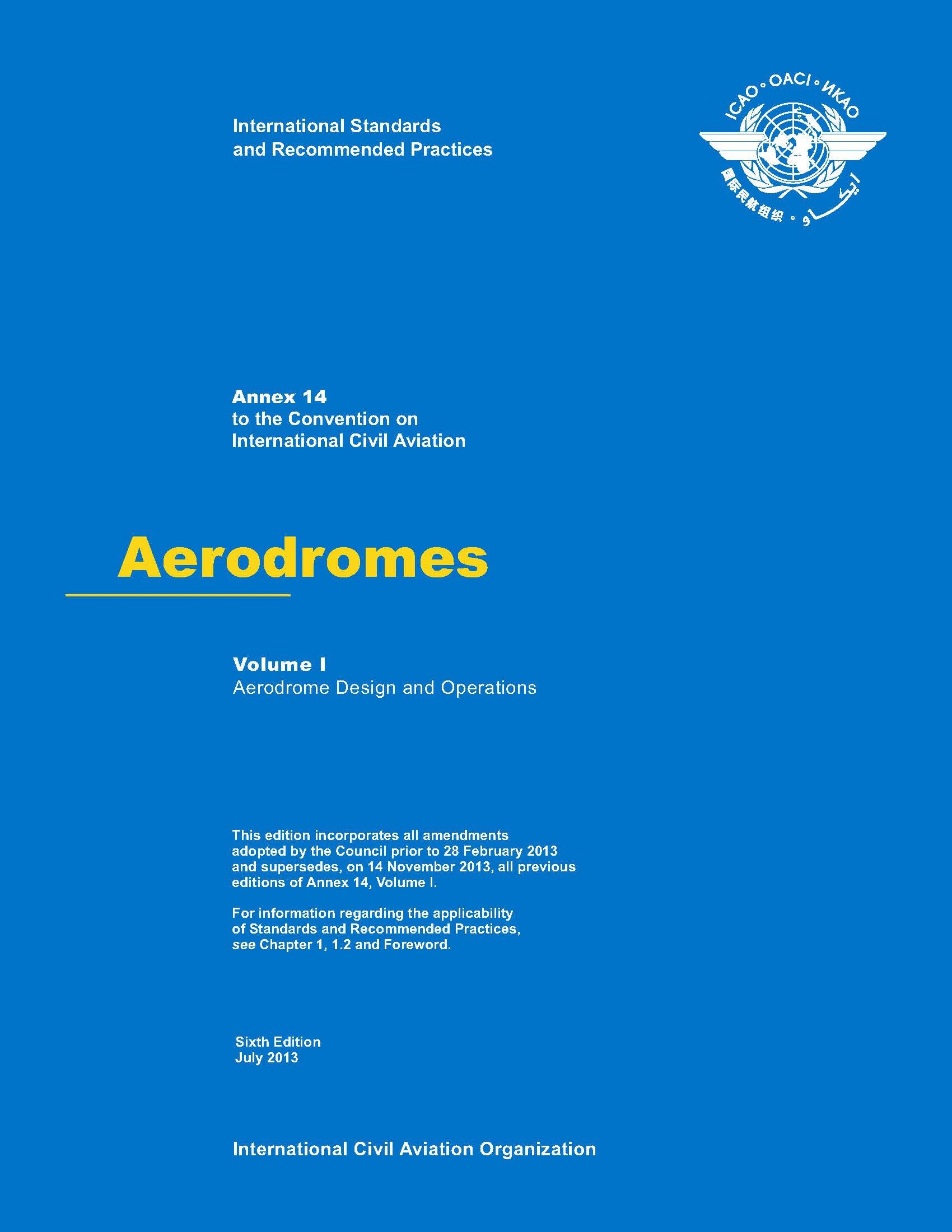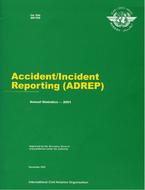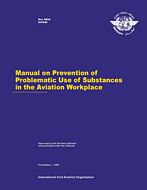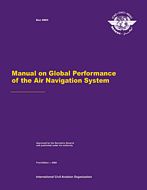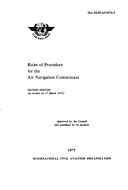Provide PDF Format
ICAO AN 14-1
- Annex 14 - Aerodromes Volume I - Aerodrome Design and Operations - Includes Amendments 1-12
- standard by International Civil Aviation Organization, 2013
- Publisher: ICAO
$135.00$269.00
Aerodromes
A distinction of Annex 14 is the broad range of subjects it contains. It extends from the planning of airports andheliports to such details as switch-over times for secondary power supply; from civil engineering to illumination engineering; from provision of sophisticated rescue and fire fighting equipment to simple requirements for keeping airports clear of birds. The impact of these numerous subjects on the Annex is compounded by the rapidly changing industry which airports must support. New aircraft models, increased aircraft operations, operations in lower visibilities and technological advances in airport equipment combine to make Annex 14 one of the most rapidly changing Annexes. This 5th edition of the Annex incorporates Amendments 1-10A. English versions of Amendment 10B plus Corrigendum 1are also included.
Annex 14, Volume I, is also unique: it is applicable to all airports open to public use in accordance with the requirements of Article 15 of the Convention. Historically, it came to life in 1951 with 61 pages of Standards and Recommended Practices and 13 additional pages on guidance for their implementation. That edition included specifications for water aerodromes and aerodromes without runways; specifications that no longer appear. Today over 180 pages of specifications and additional pages of guidance material set forth the requirements for international airports around the world.
The contents of Volume I reflect, to varying extents, the planning and design, as well as operation and maintenance, of aerodromes. The heart of the airport is the vast movement area extending from the runway, along the taxiways and onto the apron. Today's large modern aircraft require a more exacting design of these facilities. Specifications on their physical characteristics, i.e. width, surface slope and separation distances from other facilities, form a principal part of this Annex. Specifications for new facilities, unheard of at the beginning of ICAO, such as runway end safety areas, clearways and stopways, are all set forth. These facilities are the building blocks for airports which define its over-all shape and size and permit engineers to lay out the skeleton that forms the airport's basic structure.
Along with defining the ground environment of an airport, specifications are also required to define its airspacerequirements. Airports must have airspace free from obstacles in order for aircraft to approach and depart safely from the airport. It is also important that the volume of this space be defined so that it may be protected to ensure the continued growth and existence of the airport or, as stated in the Annex, ". . . to prevent the aerodromes from becoming unusable by the growth of obstacles . . . by establishing a series of obstacle limitation surfaces that define the limits to which objects may project into the airspace". The requirements to provide a particular obstacle limitation surface and the dimensions of the surfaces are classified in the Annex by runway type. Six different types of runway are recognized:non-instrument approach runways, non-precision approach runways, precision approach runways categories I, II and III, and takeoff runways.
A striking feature of airports at night are the hundreds, sometimes thousands of lights used to guide and control aircraft movements. In contrast to flight, where guidance and control are done through radio aids, movements on the ground are primarily guided and controlled through visual aids. Annex 14, Volume I, defines in detail numerous systems for use under various types of meteorological conditions and other circumstances. As these visual aids must be immediately understandable by pilots from all over the world, standardization of their location and light characteristics is highly important. Recent advances in lighting technology have led to great increases in the intensity of lights. Also in recent years, the development of small light sources has facilitated the installation of lights in the surface of pavements that can be run over by aircraft. Modern high intensity lights are effective for both day and night operations and, in some day conditions, simple markings may be highly effective. Their uses are defined in the Annex as well. Airport signs are a third type of visual aid. At large airports and airports with heavy traffic it is important that guidance be provided to pilots to permit them to find their way about the movement area.
The objective of most specifications is to improve the safety of aviation. One section of Annex 14, Volume I, is devoted to improving the safety of equipment installed at airports. Particularly noteworthy are specifications concerning the construction and siting of equipment near runways. This is to reduce the hazard such equipment might pose to aircraft operations. Requirements for secondary power supply are also specified, along with the characteristics of light circuit design and the need to monitor the operation of visual aids.In recent years more attention has been given to the operation of airports. The current edition of Annex 14, Volume I, includes specifications on maintenance of airports. Particular emphasis is given to pavement areas and visual aids. Attention is also given to eliminating features of airports which may be attractive to birds that endanger aircraft operation.
Of critical importance to the operation of any airport is the rescue and fire fighting service which, according to Annex 14, all international airports are required to have. The Annex sets forth the agents to be used, their amounts and the time limits in which they must be delivered to the scene of an aircraft accident.To take off and land safely and routinely today's aircraft require accurate information on the condition of facilities at airports. Annex 14, Volume I, sets forth: what information is to be provided; how it is to be determined; how it is to be reported; and to whom it is to be reported. (Specifications for the transmittal of this information through AIPs and NOTAMs are set out in Annex 15 - Aeronautical Information Services.) Typical of the type of information to be reported are elevation of different parts of the airport, strength of pavements, condition of runway surfaces and the level of airport rescue and fire fighting services.
Provisions for heliports are included in Volume II of Annex 14.
A distinction of Annex 14 is the broad range of subjects it contains. It extends from the planning of airports andheliports to such details as switch-over times for secondary power supply; from civil engineering to illumination engineering; from provision of sophisticated rescue and fire fighting equipment to simple requirements for keeping airports clear of birds. The impact of these numerous subjects on the Annex is compounded by the rapidly changing industry which airports must support. New aircraft models, increased aircraft operations, operations in lower visibilities and technological advances in airport equipment combine to make Annex 14 one of the most rapidly changing Annexes. This 5th edition of the Annex incorporates Amendments 1-10A. English versions of Amendment 10B plus Corrigendum 1are also included.
Annex 14, Volume I, is also unique: it is applicable to all airports open to public use in accordance with the requirements of Article 15 of the Convention. Historically, it came to life in 1951 with 61 pages of Standards and Recommended Practices and 13 additional pages on guidance for their implementation. That edition included specifications for water aerodromes and aerodromes without runways; specifications that no longer appear. Today over 180 pages of specifications and additional pages of guidance material set forth the requirements for international airports around the world.
The contents of Volume I reflect, to varying extents, the planning and design, as well as operation and maintenance, of aerodromes. The heart of the airport is the vast movement area extending from the runway, along the taxiways and onto the apron. Today's large modern aircraft require a more exacting design of these facilities. Specifications on their physical characteristics, i.e. width, surface slope and separation distances from other facilities, form a principal part of this Annex. Specifications for new facilities, unheard of at the beginning of ICAO, such as runway end safety areas, clearways and stopways, are all set forth. These facilities are the building blocks for airports which define its over-all shape and size and permit engineers to lay out the skeleton that forms the airport's basic structure.
Along with defining the ground environment of an airport, specifications are also required to define its airspacerequirements. Airports must have airspace free from obstacles in order for aircraft to approach and depart safely from the airport. It is also important that the volume of this space be defined so that it may be protected to ensure the continued growth and existence of the airport or, as stated in the Annex, ". . . to prevent the aerodromes from becoming unusable by the growth of obstacles . . . by establishing a series of obstacle limitation surfaces that define the limits to which objects may project into the airspace". The requirements to provide a particular obstacle limitation surface and the dimensions of the surfaces are classified in the Annex by runway type. Six different types of runway are recognized:non-instrument approach runways, non-precision approach runways, precision approach runways categories I, II and III, and takeoff runways.
A striking feature of airports at night are the hundreds, sometimes thousands of lights used to guide and control aircraft movements. In contrast to flight, where guidance and control are done through radio aids, movements on the ground are primarily guided and controlled through visual aids. Annex 14, Volume I, defines in detail numerous systems for use under various types of meteorological conditions and other circumstances. As these visual aids must be immediately understandable by pilots from all over the world, standardization of their location and light characteristics is highly important. Recent advances in lighting technology have led to great increases in the intensity of lights. Also in recent years, the development of small light sources has facilitated the installation of lights in the surface of pavements that can be run over by aircraft. Modern high intensity lights are effective for both day and night operations and, in some day conditions, simple markings may be highly effective. Their uses are defined in the Annex as well. Airport signs are a third type of visual aid. At large airports and airports with heavy traffic it is important that guidance be provided to pilots to permit them to find their way about the movement area.
The objective of most specifications is to improve the safety of aviation. One section of Annex 14, Volume I, is devoted to improving the safety of equipment installed at airports. Particularly noteworthy are specifications concerning the construction and siting of equipment near runways. This is to reduce the hazard such equipment might pose to aircraft operations. Requirements for secondary power supply are also specified, along with the characteristics of light circuit design and the need to monitor the operation of visual aids.In recent years more attention has been given to the operation of airports. The current edition of Annex 14, Volume I, includes specifications on maintenance of airports. Particular emphasis is given to pavement areas and visual aids. Attention is also given to eliminating features of airports which may be attractive to birds that endanger aircraft operation.
Of critical importance to the operation of any airport is the rescue and fire fighting service which, according to Annex 14, all international airports are required to have. The Annex sets forth the agents to be used, their amounts and the time limits in which they must be delivered to the scene of an aircraft accident.To take off and land safely and routinely today's aircraft require accurate information on the condition of facilities at airports. Annex 14, Volume I, sets forth: what information is to be provided; how it is to be determined; how it is to be reported; and to whom it is to be reported. (Specifications for the transmittal of this information through AIPs and NOTAMs are set out in Annex 15 - Aeronautical Information Services.) Typical of the type of information to be reported are elevation of different parts of the airport, strength of pavements, condition of runway surfaces and the level of airport rescue and fire fighting services.
Provisions for heliports are included in Volume II of Annex 14.
Related Products
ICAO CIR294
Circular 294 - Accident/Incident Reporting (ADREP) Annual Statistics - 2001 (Circ 294)..
$26.00 $51.00
ICAO 9654
Manual on Prevention of Problematic Use of Substances in the Aviation Workplace. (Doc 9654-AN/945)..
$52.00 $104.00

